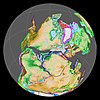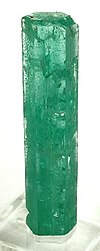Rosablanca Formation
| Rosablanca Formation | |
|---|---|
| Stratigraphic range: Valanginian ~ | |
| Type | Geological formation |
| Underlies | Paja Fm., Ritoque Fm. |
| Overlies | Cumbres Fm., Girón Fm., Los Medios Fm. |
| Thickness | ~470 m (1,540 ft) |
| Lithology | |
| Primary | Sandstone |
| Other | Shale |
| Location | |
| Coordinates | 4°27′07″N 74°03′20″W / 4.45194°N 74.05556°WCoordinates: 4°27′07″N 74°03′20″W / 4.45194°N 74.05556°W |
| Region | Altiplano Cundiboyacense Eastern Ranges, Andes |
| Country | |
| Type section | |
| Named by | Wheeler |
| Location | Mesa de Los Santos |
| Year defined | 1929 |
| Coordinates | 4°27′07″N 74°03′20″W / 4.45194°N 74.05556°W |
| Region | Boyacá, Santander |
| Country | |
The Rosablanca Formation (Spanish: Formación Rosablanca, Kir) is a geological formation of the Altiplano Cundiboyacense, Eastern Ranges of the Colombian Andes and the Middle Magdalena Basin. The formation consists of grey limestones, dolomites and shales with at the upper part sandstones. The formation dates to the Early Cretaceous period; Valanginian epoch and has a thickness of 425 metres (1,394 ft) in the valley of the Sogamoso River.
Definition
The formation was first defined by Wheeler in 1929.[1]
Description
Lithologies
The Rosablanca Formation is characterised by a sequence of grey limestones, dolomites and shales with a maximum thickness of 425 metres (1,394 ft) in the Sogamoso River valley.[1]
Stratigraphy and depositional environment
The Rosablanca Formation overlies the Arcabuco Formation and is overlain by the Ritoque Formation. The age has been estimated to be Valanginian. Stratigraphically, the formation is time equivalent with the Macanal Formation.[1]
Fossils
Fossils of the decapod crustacean Diaulax rosablanca have been found in and named after the Rosablanca Formation.[2] In 2019, fossils of brachiopodSellithyris elizabetha were described from the formation.[3] In 2020 remains of indeterminate pterosaurs were described from the formation, including pterodactyloids and non-Pteranodontian ornithocheiroids.[4] In 2005 the remains of Platychelyid sea turtle Notoemys zapatocaensis were described.
Outcrops
The Rosablanca Formation is found, apart from its type locality on the Mesa de Los Santos, Santander, in Boyacá and the Middle Magdalena Basin.
Regional correlations
- Legend
- group
- important formation
- fossiliferous formation
- minor formation
- (age in Ma)
- proximal Llanos (Medina)[note 1]
- distal Llanos (Saltarin 1A well)[note 2]
See also
Notes and references
Notes
References
- ^ a b c Galvis & Valencia, 2009, p.17
- ^ Gómez et al., 2015
- ^ Rojas & Sandy, 2019
- ^ Cadena, Edwin-Alberto; Unwin, David M.; Martill, David M. (2020-10-01). "Lower Cretaceous pterosaurs from Colombia". Cretaceous Research. 114: 104526. doi:10.1016/j.cretres.2020.104526. ISSN 0195-6671.
- ^ a b c d e f García González et al., 2009, p.27
- ^ a b c d e f García González et al., 2009, p.50
- ^ a b García González et al., 2009, p.85
- ^ a b c d e f g h i j Barrero et al., 2007, p.60
- ^ a b c d e f g h Barrero et al., 2007, p.58
- ^ Plancha 111, 2001, p.29
- ^ a b Plancha 177, 2015, p.39
- ^ a b Plancha 111, 2001, p.26
- ^ Plancha 111, 2001, p.24
- ^ Plancha 111, 2001, p.23
- ^ a b Pulido & Gómez, 2001, p.32
- ^ Pulido & Gómez, 2001, p.30
- ^ a b Pulido & Gómez, 2001, pp.21-26
- ^ Pulido & Gómez, 2001, p.28
- ^ Correa Martínez et al., 2019, p.49
- ^ Plancha 303, 2002, p.27
- ^ Terraza et al., 2008, p.22
- ^ Plancha 229, 2015, pp.46-55
- ^ Plancha 303, 2002, p.26
- ^ Moreno Sánchez et al., 2009, p.53
- ^ Mantilla Figueroa et al., 2015, p.43
- ^ Manosalva Sánchez et al., 2017, p.84
- ^ a b Plancha 303, 2002, p.24
- ^ a b Mantilla Figueroa et al., 2015, p.42
- ^ Arango Mejía et al., 2012, p.25
- ^ Plancha 350, 2011, p.49
- ^ Pulido & Gómez, 2001, pp.17-21
- ^ Plancha 111, 2001, p.13
- ^ Plancha 303, 2002, p.23
- ^ Plancha 348, 2015, p.38
- ^ Planchas 367-414, 2003, p.35
- ^ Toro Toro et al., 2014, p.22
- ^ Plancha 303, 2002, p.21
- ^ a b c d Bonilla et al., 2016, p.19
- ^ Gómez Tapias et al., 2015, p.209
- ^ a b Bonilla et al., 2016, p.22
- ^ a b Duarte et al., 2019
- ^ García González et al., 2009
- ^ Pulido & Gómez, 2001
- ^ García González et al., 2009, p.60
Bibliography
- , and . 2009. Contribución en la determinación de los posibles paleoambientes de las rocas Cretáceas Tempranas sobre la vía Tunja-Villa de Leyva (entre Alto del Arrayán - Peaje Sáchica) y sectores aledaños, departamento de Boyacá, 1–127. Universidad de Caldas.
- ; , and . 2015. A new species of Diaulax Bell, 1863 (Brachyura: Dialucidae) in the Early Cretaceous of the Rosablanca Formation, Colombia. Boletín de la Sociedad Geológica Mexicana 67. 103-112. Accessed 2017-04-04.
- , and . 2019. Early Cretaceous (Valanginian) brachiopods from the Rosablanca Formation, Colombia, South America: Biostratigraphic significance and paleogeographic implications. Cretaceous Research 96. 184–195. Accessed 2019-02-11.
- . 2012. Chronology Relative Sea Level History and a New Sequence Stratigraphic Model for Basinal Cretaceous Facies of Colombia, 161–216. Society for Sedimentary Geology (SEPM).
Maps
- , and . 2006. Plancha 85 - Simití - 1:100,000, 1. INGEOMINAS. Accessed 2017-06-06.
- , and . 2006. Plancha 96 - Bocas del Rosario - 1:100,000, 1. INGEOMINAS. Accessed 2017-06-06.
- , and . 2009. Plancha 97 - Cáchira - 1:100,000, 1. INGEOMINAS. Accessed 2017-06-06.
- , and . 2008. Plancha 119 - Barrancabermeja - 1:100,000, 1. INGEOMINAS. Accessed 2017-06-06.
- ; ; ; ; , and . 2010. Plancha 120 - Bucaramanga - 1:100,000, 1. INGEOMINAS. Accessed 2017-06-06.
- ; ; ; ; ; ; ; , and . 2008. Plancha 134 - Puerto Parra - 1:100,000, 1. INGEOMINAS. Accessed 2017-06-06.
- ; ; ; ; ; ; ; , and . 2009. Plancha 135 - San Gil - 1:100,000, 1. INGEOMINAS. Accessed 2017-06-06.
- ; ; ; ; ; ; ; , and . 2008. Plancha 150 - Cimitarra - 1:100,000, 1. INGEOMINAS. Accessed 2017-06-06.
- . 2009. Plancha 151 - Charalá - 1:100,000, 1. INGEOMINAS. Accessed 2017-06-06.
- , and . 2009. Plancha 170 - Vélez - 1:100,000, 1. INGEOMINAS. Accessed 2017-06-06.
- , and . 2009. Plancha 171 - Duitama - 1:100,000, 1. INGEOMINAS. Accessed 2017-06-06.
- , and . 2009. Plancha 190 - Chiquinquirá - 1:100,000, 1. INGEOMINAS. Accessed 2017-06-06.
- ; , and . 1998. Plancha 191 - Tunja - 1:100,000, 1. INGEOMINAS. Accessed 2017-06-06.
External links
- ; ; , and . 2015. Plancha 5-09 del Atlas Geológico de Colombia 2015 – escala 1:500,000, 1. Servicio Geológico Colombiano. Accessed 2017-03-16.
- Articles with short description
- Short description with empty Wikidata description
- Coordinates not on Wikidata
- Articles containing Spanish-language text
- Geologic formations of Colombia
- Cretaceous Colombia
- Lower Cretaceous Series of South America
- Valanginian Stage
- Limestone formations
- Shallow marine deposits
- Colombian emeralds
- Altiplano Cundiboyacense
- Geography of Boyacá Department
- Geography of Santander Department


























